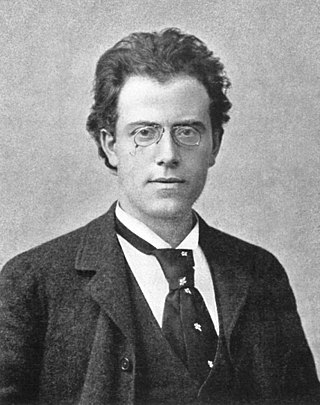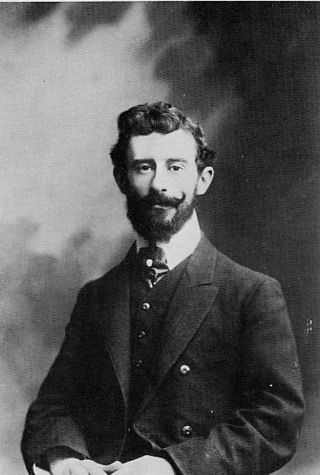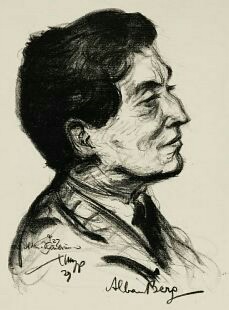The Pomp and Circumstance Marches are a series of five marches for orchestra composed by Edward Elgar, together with a sixth march created from sketches. The marches were dedicated to his friends including composer Granville Bantock and organists George Robertson Sinclair, Ivor Atkins and Percy Hull.

The Symphony No. 1 in D major by Gustav Mahler was mainly composed between late 1887 and March 1888, though it incorporates music Mahler had composed for previous works. It was composed while Mahler was second conductor at the Leipzig Opera in Germany. Although in his letters Mahler almost always referred to the work as a symphony, the first two performances described it as a symphonic poem and as a tone poem in symphonic form, respectively. The work was premièred at the Vigadó Concert Hall in Budapest, Hungary, in 1889, but was not well-received. Mahler made some major revisions for the second performance, given at Hamburg, Germany, in October 1893; further alterations were made in the years prior to the first publication, in late 1898. Some modern performances and recordings give the work the title Titan, despite the fact that Mahler only used this label for the second and third performances, and never after the work had reached its definitive four-movement form in 1896.

Capriccio espagnol, Op. 34, is the common Western title for a five movement orchestral suite, based on Spanish folk melodies, composed by the Russian composer Nikolai Rimsky-Korsakov in 1887. It received its premiere on 31 October 1887, in St. Petersburg, performed by the Imperial Orchestra conducted by the composer. Rimsky-Korsakov originally intended to write the work for a solo violin with orchestra, but later decided that a purely orchestral work would do better justice to the lively melodies. The Russian title is Каприччио на испанские темы.

The Symphony No. 8 in G major, Op. 88, B. 163, is a symphony by Antonín Dvořák, composed in 1889 at Vysoká u Příbramě, Bohemia, on the occasion of his election to the Bohemian Academy of Science, Literature and Arts. Dvořák conducted the premiere in Prague on 2 February 1890. In contrast to other symphonies of both the composer and the period, the music is cheerful and optimistic. It was originally published as Symphony No. 4.

Miroirs is a five-movement suite for solo piano written by French composer Maurice Ravel between 1904 and 1905. First performed by Ricardo Viñes in 1906, Miroirs contains five movements, each dedicated to a fellow member of the French avant-garde artist group Les Apaches.

Till Eulenspiegel's Merry Pranks, Op. 28, is a tone poem written in 1894–95 by Richard Strauss. Dedicated to his friend Arthur Seidl, it was first performed on 6 May 1895 by the Gürzenich Orchestra Cologne conducted by Franz Wüllner.
The alto clarinet is a woodwind instrument of the clarinet family. It is a transposing instrument pitched in the key of E♭, though instruments in F have been made. In size it lies between the soprano clarinet and the bass clarinet. It bears a greater resemblance to the bass clarinet in that it typically has a straight body, but a curved neck and bell made of metal. All-metal alto clarinets also exist. In appearance it strongly resembles the basset horn, but usually differs in three respects: it is pitched a whole step lower, it lacks an extended lower range, and it has a wider bore than many basset horns.
English Folk Song Suite is one of English composer Ralph Vaughan Williams' most famous works. It was first published for the military band as Folk Song Suite and its premiere was given at Kneller Hall on 4 July 1923, conducted by Lt Hector Adkins. The piece was then arranged for full orchestra in 1924 by Vaughan Williams' student Gordon Jacob and published as English Folk Song Suite. The piece was later arranged for British-style brass band in 1956 by Frank Wright and published as English Folk Songs Suite. All three versions were published by Boosey & Hawkes; note the use of three different titles for the three different versions. The suite uses the melodies of nine English folk songs, six of which were drawn from the collection made by Vaughan Williams' friend and colleague Cecil Sharp.
Music for Prague 1968 is a programmatic work written by Czech-born composer Karel Husa for symphonic band and later transcribed for full orchestra, written shortly after the Soviet Union crushed the Prague Spring reform movement in Czechoslovakia in 1968. Karel Husa was sitting on the dock at his cottage in America at the time, listening to the BBC broadcast of the events on the radio. He was deeply moved, and wrote Music for Prague 1968 to memorialize the events. This piece is a standard among wind ensemble repertoire.
Molly on the Shore is a composition by Percy Aldridge Grainger. It is an arrangement of two contrasting Irish reels, "Temple Hill" and "Molly on the Shore", that presents the melodies in a variety of textures and orchestrations, giving each section of the band long stretches of thematic and counter melodic material. The two reel tunes used by Grainger can be found in the Complete Petrie Collection of Ancient Irish Music as numbers 901 and 902. It was written in 1907 by Grainger as a birthday gift for his mother, Rose Annie Aldridge.
The First Suite in E♭ for Military Band, Op. 28, No. 1 is written by the English composer Gustav Holst. It is considered one of the cornerstone masterworks in the concert band repertoire. Officially premiered in 1920 at the Royal Military School of Music, the manuscript was originally completed in 1909. Along with the subsequent Second Suite in F for Military Band, written in 1911 and premiered in 1922, the First Suite convinced many other prominent composers that serious music could be written specifically for band.
The Second Suite in F for Military Band is Gustav Holst's second of his two suites for concert band. Although performed less frequently than the First Suite in E♭, it is still a staple of the band repertoire. The Second Suite, written in 1911 and first published in 1922, dedicated to James Causley Windram, is longer and considered more difficult to play than its sister suite.
Dennis Ferry is an internationally known trumpeter and the former Principal Trumpet of the Orchestre de la Suisse Romande in Geneva, a position that he held from October 1977 until January 2009.

The Kammerkonzert für Klavier und Geige mit 13 Bläsern is a piece of chamber music composed by Austrian composer Alban Berg. It was composed between 1923 and 1925. The short score was completed on 9 February 1925; the full score was finished on 23 July 1925. The work was premiered on 19 March 1927.
October is a contemporary piece for concert band approximately six minutes in duration that was written by Eric Whitacre in 2000.

Colonial Song is a musical composition written by Australian composer Percy Grainger. Although Grainger created versions for different types of musical ensembles, its most commonly used version today is for concert band.
The Year of the Dragon is a musical composition by Philip Sparke originally written for the internationally acclaimed and awarded Cory Band's Centenary Celebrations held at St. David's Hall in Cardiff in March 1984. The composition has since made a regular appearance worldwide as a test piece for brass band competitions.
Composed in 1957, Symphonic Songs for Band is one of Robert Russell Bennett's most famous compositions for wind band. The work was commissioned for the National Intercollegiate Band by Kappa Kappa Psi and Tau Beta Sigma, national honorary band fraternity and sorority, as part of the two organizations' commissioning program. Since its premiere, it has become among the most frequently performed works in the wind band repertoire. It is considered to be a cornerstone of the band literature.
Russian composer Alfred Schnittke's Symphony No. 7 was composed in 1993. It is dedicated to conductor Kurt Masur who gave its world premiere performance in New York with the New York Philharmonic Orchestra on 10 February 1994.

Children's March: Over the Hills and Far Away was written by Percy Grainger as his first original work for band.












